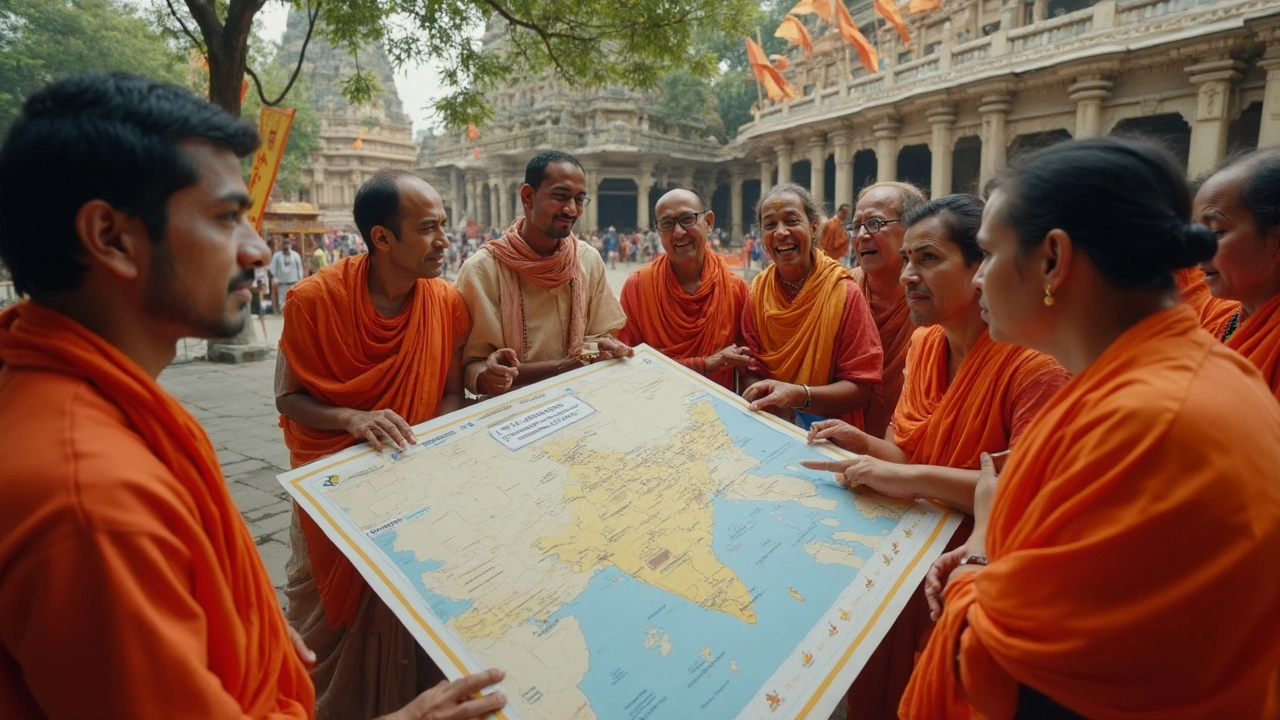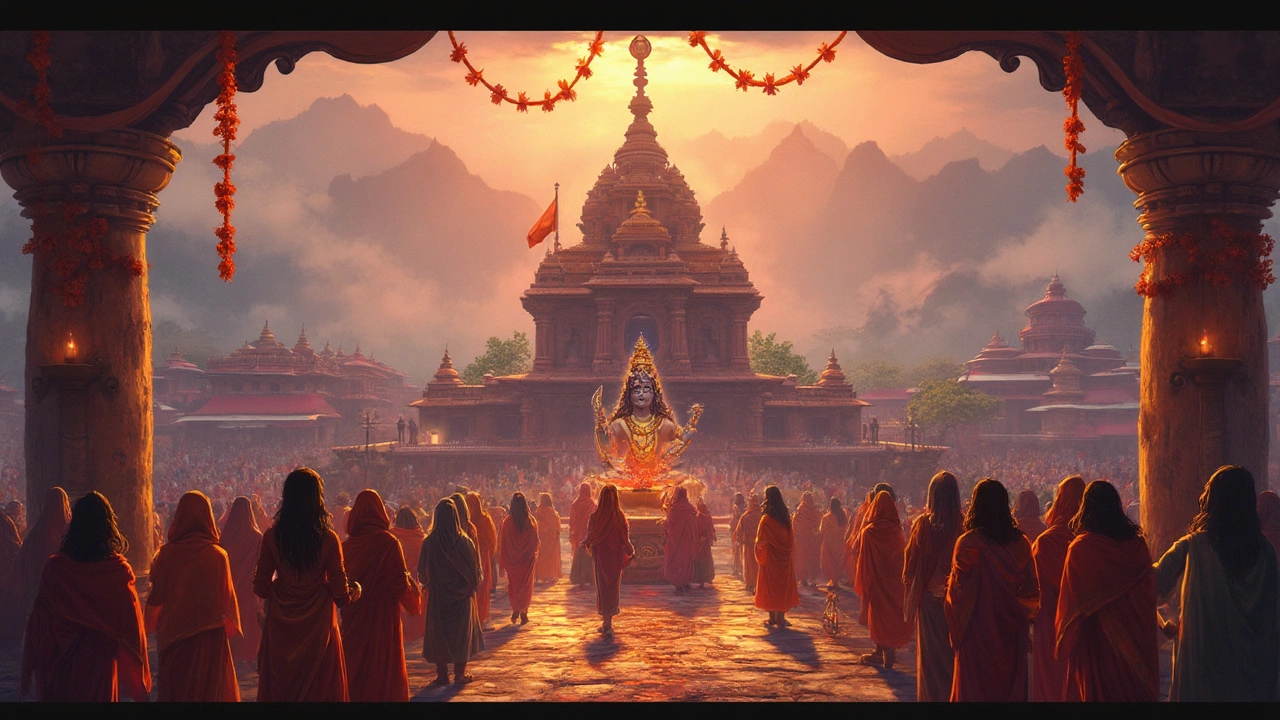Ask any group of Shiva devotees, and the debate gets heated fast—everyone has their favorite Jyotirlinga. But what really makes one ‘more powerful’ than the others? Is it the miracles, the legends, the energy you feel standing in the temple, or just the buzz around it?
If you’re new to this, let’s set the record straight. Jyotirlingas are shrines where Shiva supposedly appeared in a column of light. There are twelve of these across India, each with its own wild stories, rituals, and crowds. People travel thousands of kilometers hoping for blessings, cures, or peace—sometimes all three.
Every temple claims a unique spark. Some are famous for intense rituals, others for jaw-dropping old architecture, and a few for wish-fulfilling tales that have drawn saints and celebrities alike. But is there solid proof that one is more ‘powerful’ than the rest, or is it all about personal faith and the vibe you get standing there?
Before planning your own tour—whether to Kashi Vishwanath, Somnath, Trimbakeshwar or another—let’s cut through the hype, sort through the facts, and see what real pilgrims experience when they chase this so-called spiritual power.
- The Basics: What’s a Jyotirlinga?
- The Contenders: Most Powerful Jyotirlingas
- Stories vs. Reality: Power, Belief, and Miracles
- Making Your Pilgrimage: Tips and Things Nobody Tells You
The Basics: What’s a Jyotirlinga?
First off, the word “Jyotirlinga” sounds pretty intense, but it’s actually straightforward. “Jyoti” means light, and “linga” is a symbol of Shiva, so when you put it together, it’s basically “the linga of light.” According to old Hindu texts, there are twelve places across India where Shiva revealed himself as a column of blazing light—these are called the Jyotirlingas.
Most people think there’s some kind of mystical energy at these spots. Pilgrims believe a visit to any Jyotirlinga can wash away your past mistakes (yeah, even the embarrassing ones) and bring blessings. But they’re not just sacred—these places also have big crowds, old-school rituals, and are magnets for spiritual travelers.
Here’s what’s pretty unique about the Jyotirlingas:
- There are twelve main Jyotirlingas, each in a different city or state.
- No two Jyotirlingas look exactly alike—some are deep in caves, others inside massive temples.
- Each site has its own legend, often with wild stories about kings, saints, and divine appearances.
If you’re wondering how old these places are, most of the temples built there now are at least a few hundred years old, but the legends go back thousands of years. The Somnath Jyotirlinga, for example, was even mentioned in ancient texts and has been rebuilt more than five times—thanks to a history of invasions and natural disasters.
| Name | Location | Fun Fact |
|---|---|---|
| Somnath | Gujarat | Destroyed and rebuilt at least 17 times |
| Kashi Vishwanath | Varanasi, UP | Located in India’s spiritual capital |
| Trimbakeshwar | Maharashtra | Has three faces on the linga (rare!) |
| Kedarnath | Uttarakhand | Only accessible part of the year due to snow |
Many locals and travelers use the Jyotirlinga circuit as a way to see India’s culture and spiritual side up close. So, next time you hear people talk about temple tours, you’ll know that these twelve shrines aren’t just random old buildings—they’re considered the ‘main event’ for Shiva devotees, and each one feels totally different.
The Contenders: Most Powerful Jyotirlingas
When you start asking around about the "most powerful" jyotirlinga, three big names always come up: Somnath, Kashi Vishwanath, and Mahakaleshwar. Each of these temples has a completely different feel and stories that go back centuries. Here’s what actually puts them in the spotlight.
Somnath Jyotirlinga in Gujarat is a must-see if you care about history. This temple has been raided, rebuilt, and restored more than six times! Some say this shows its lasting spiritual pull. Pilgrims believe praying here can wipe away deep-rooted fears and worries. Even if you’re not spiritual, just standing on the sea-facing temple walls, you feel something.
Kashi Vishwanath Jyotirlinga in Varanasi is probably the busiest. Ask a local and they’ll say the Shiva here—who’s known as the “Lord of the Universe”—protects you in life and even after. The chaos of the city, the dense crowds, and the constant ringing of bells make the energy here almost electric. Loads of devotees think that one darshan here changes your whole karma.
Mahakaleshwar Jyotirlinga in Ujjain has a totally different vibe. It’s famous for its Bhasma Aarti, where the lingam gets covered in sacred ash at dawn. This temple is especially popular with people hoping to beat bad luck or negative energy in their lives. Watching the aarti in person is honestly a bucket-list experience for many.
- Trimbakeshwar Jyotirlinga in Maharashtra is another hotshot. It’s where the Godavari river starts, and folks believe the water has healing powers. The temple is also big for rituals related to ancestors.
- Kedarnath Jyotirlinga in the Himalayas might win for sheer adventure. Getting there isn’t easy, but those who make the trek say the location itself makes you feel closer to something bigger—call it nature, Shiva, or just the clear mountain air.
So, is there a single powerful Jyotirlinga? Depends who you ask. Locals at every shrine will tell you theirs is the real deal. But honestly, their claim isn’t just talk—there are decades, sometimes hundreds of years, of belief and personal stories behind each one. If you want to decide for yourself, you’ve got to visit and see which energy hits you hardest.

Stories vs. Reality: Power, Belief, and Miracles
Walk into any Jyotirlinga temple and you’ll hear stories that sound bigger than life. Some folks swear that Somnath survived repeated invasions—rebuilt every time the world tried tearing it down. Kashi Vishwanath gets credit for granting moksha, or freedom from the cycle of death and rebirth. Nageshwar is known for stories where even deadly snakes bowed out. Locals will tell you about people who walked in sick and came out healthy, or solved the problems nobody else could fix.
Now, what’s actual fact and what’s just faith? It’s tough to separate. If you’re a believer, you don’t care about proof, but if you’re all about evidence, here’s what you get: no scientific studies confirm miracles at any Jyotirlinga. What’s real, though, is the raw energy in these places—sometimes the crowd’s devotion itself can feel electric. Here’s a quick look at what visitors and records actually say:
| Jyotirlinga | Claimed Miracle or Power | Any Evidence? |
|---|---|---|
| Somnath | Rebuilt 17 times after invasions | Historical records support repeated reconstructions |
| Kashi Vishwanath | Grants moksha (liberation) | Lots of written spiritual accounts, no measurement possible |
| Trimbakeshwar | Restores health, cleanses sins | Devotees’ testimonials; no medical proof |
| Nageshwar | Saves from poison, especially snake bites | Mostly stories passed through generations |
Want some ground-level feedback? Ask the temple priests, and they’ll insist on their shrine’s powers. Tour guides, on the other hand, might toss in a couple of eerie tales to keep you hooked. Local shop owners will sell you herbs and amulets “blessed” by the Jyotirlinga, just in case you need an extra push.
- If you’re heading to a temple expecting a miracle, know this: Thousands claim they feel lighter or more peaceful after darshan (viewing the deity). Stress relief and hope? That’s pretty common, and maybe worth the trip alone.
- Don’t ignore the practical side—these temples see massive crowds. During major festivals, Kashi Vishwanath can have over 150,000 visitors in a day. Energy? Plenty. Instant magic? That depends on you.
- Real power, for most, comes from the rituals: the chants, the community, the sense of being part of a tradition. Whether that’s faith or science, well, you decide.
Making Your Pilgrimage: Tips and Things Nobody Tells You
Most people imagine temple tours in India as peaceful getaways, but visiting a Jyotirlinga can test your patience and stamina. Here’s what nobody tells you before you book that ticket.
- Beat the stampede by starting early: The best time to enter is around 4–5 AM. After 7 AM, queues can stretch for hours, especially at Somnath and Kashi Vishwanath—think 10,000+ visitors on special days.
- No shoes, no phones, strict checks: Most Jyotirlingas don’t allow phones, cameras, or even bags past a certain point. Lockers get full fast, so travel light.
- Dress code is real: Men often need to wear dhotis (sometimes no shirts!); women are expected to wear sarees or salwar kameez. Security will turn you away if you miss this.
- Prasad isn’t always free: At some temples, the official prasad comes with a set fee. Ignore touts claiming ‘exclusive access’—they’re just after your money.
- Local guides can be helpful or pushy: Choose government-registered guides if you want real facts instead of endless stories and pressure tactics.
If you’re trying to visit more than one Jyotirlinga in one trip, figure out train routes and connections ahead of time—flights sometimes get canceled last minute, especially in monsoon seasons. Three Jyotirlingas (Kedarnath, Kashi Vishwanath, and Mahakaleshwar) are in areas prone to heavy rain and flooding from June to September. Here’s a quick snapshot of crowd levels and access months:
| Jyotirlinga | Peak Months | Average Daily Crowd | Best Season |
|---|---|---|---|
| Somnath | Oct–Feb | 7,000–20,000 | Winter |
| Kashi Vishwanath | Mar–Jul | 10,000–40,000 | Spring/Summer |
| Kedarnath | May–Jun | 5,000–15,000 | Late Spring |
| Trimbakeshwar | Jul–Sep (Shravan) | 6,000–14,000 | Monsoon |
Try not to book everything last minute. For Kedarnath, Uttarakhand government has made online darshan registration compulsory after 2023—no ID, no entry.
One last thing: don’t expect miracles if you’re going just out of curiosity. The biggest stories you’ll hear come from folks who went in with an open mind and no set agenda. Whether you’re a believer or just love old temples, know what you’re signing up for, pack for chaos, and you’ll walk away with a story worth telling.
